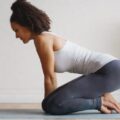Running is an excellent cardiovascular exercise, but it often leads to tight hips which can cause discomfort and impact performance. Incorporating yoga stretches into your routine can help alleviate this tension and improve flexibility. Here are three essential yoga stretches every runner should know to release tight hips.
1. Pigeon Pose (Eka Pada Rajakapotasana)
The Pigeon Pose is a deep hip opener that can significantly release tension in the hip flexors and glutes.
- How to do it: Begin in a tabletop position. Bring your right knee forward and place it behind your right wrist with your ankle near your left wrist. Extend your left leg back, keeping your hips square. Slowly lower your upper body over your front leg, resting on your forearms or a block. Hold for 30 seconds to 1 minute, then switch sides.
- Benefits: This pose helps to stretch the hip flexors, glutes, and lower back, providing relief from tightness.
2. Lizard Pose (Utthan Pristhasana)
Lizard Pose is excellent for targeting the hip flexors and inner thighs, making it a perfect stretch for runners.
- How to do it: Start in a downward-facing dog. Step your right foot forward outside your right hand, keeping your back leg extended. Lower your hips and bring your forearms to the ground or a block. Hold for 30 seconds to 1 minute, then switch sides.
- Benefits: This pose deeply stretches the hip flexors, groin, and hamstrings, improving overall hip mobility.
3. Butterfly Pose (Baddha Konasana)
Butterfly Pose is a gentler hip opener that focuses on the inner thighs and can be easily incorporated into any routine.
- How to do it: Sit with your feet together and your knees bent out to the sides. Hold your feet with your hands and gently press your knees towards the floor. Hold for 1-2 minutes, breathing deeply.
- Benefits: This pose helps to open the hips, stretch the inner thighs, and improve circulation in the lower body.
Tips for Incorporating Yoga into Your Running Routine
To maximize the benefits of yoga for your running routine, consider the following tips:
- Consistency: Practice these stretches regularly, ideally after your runs, to maintain flexibility and prevent tightness.
- Breathing: Focus on deep, steady breathing during each stretch to help relax your muscles and enhance the stretch.
- Warm-up: Perform a brief warm-up before stretching to increase blood flow and prepare your muscles for deeper stretches.
- Listen to Your Body: Avoid pushing yourself too hard and respect your body’s limits to prevent injury.
Benefits of Stretching for Runners
Incorporating yoga stretches into your routine offers numerous benefits for runners, including:
- Increased Flexibility: Regular stretching helps improve the range of motion in your hips, reducing the risk of injury.
- Better Performance: Enhanced flexibility can lead to more efficient running mechanics and better overall performance.
- Reduced Muscle Tension: Stretching helps to release muscle tension, leading to less discomfort and quicker recovery after runs.
- Improved Posture: Yoga stretches can help correct imbalances and improve posture, contributing to a more efficient running form.
FAQ
1. How often should runners do these yoga stretches?
It is recommended to do these yoga stretches at least three times a week, preferably after your runs when your muscles are warm.
2. Can beginners try these yoga stretches?
Yes, these stretches are suitable for beginners. Make sure to ease into each pose and use props like blocks or blankets if needed.
3. How long should each stretch be held?
Hold each stretch for 30 seconds to 1 minute, depending on your comfort level. Gradually increase the duration as you become more flexible.
4. Can these stretches help with other types of exercise?
Absolutely. These stretches are beneficial for anyone experiencing tight hips, not just runners. They can complement any fitness routine.
5. Is it normal to feel discomfort during these stretches?
It is common to feel mild discomfort as you stretch tight muscles, but you should not feel pain. If you experience pain, ease off the stretch and consult a professional if necessary.









